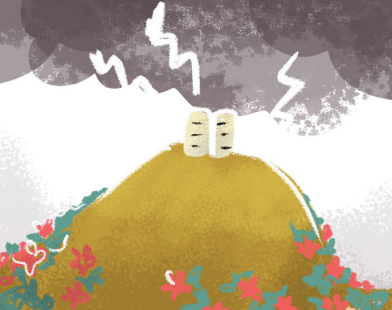Illustration Credit: Rivka Tsinman

Halakhah הֲלָכָה
Tu Bishvat, Orlah, and Neta Reva'i
Orlah עָרְלָה
For the first three years after a tree is planted, it’s called “orlah” and you can’t eat its fruit.
Neta Reva’i נֶטַע רְבָעִי
In the fourth year after a tree is planted, it’s called “neta reva’i (fourth year growth).” You can eat its fruit, but only in Yerushalayim, and you have to be טָהוֹר (tahor, pure).
Today, now that there’s no Beit Ha-Mikdash, you exchange neta reva’i fruit for a coin or for regular fruit, even if they have very little value. So a lot of neta reva’i can be exchanged for just a nickel or a single orange. Then the exchanged coin or fruit has to be wrapped up and thrown away.
We don’t actually count tree years from the date the tree is planted! We count tree years from Rosh Hashanah (the first day of Tishrei). So if you plant a tree in the springtime, in the month of Iyyar, then that tree officially turns one year old on Rosh Hashanah (even though it’s just five months later).
But fruit years start on Tu Bishvat. That means that fruit that begins to grow before Tu Bishvat of the fourth year are still orlah. But if they grow after Tu Bishvat, they’re neta reva’i. And it’s the same thing in the fifth year - if they grow before Tu Bishvat, they’re still neta reva’i, but if they grow after, then they’re totally ok to eat at home. (Just don’t forget to make a berakhah!)
Tu Bishvat, Terumah, and Ma'aser
Ma’aser מַעֲשֵׂר
Ma'aser means "a tenth."
- Farmers had to separate a tenth of their produce for different reasons in the time of the Beit Ha-Mikdash.
- Some ma'ser was given to Levi'im, some to people who were poor, and some had to be taken to Yerushalayim and eaten there.
Today, terumah and ma’aser must still be taken from fruit grown in Eretz Yisrael. Because there’s no Beit Ha-Mikdash, though, it’s much less than a tenth, and the separated fruit cannot be eaten by anyone.
Tu Bishvat is the start date for calculating how much terumah and ma’aser to give every year.
Tu Bishvat and Shemittah
Shemittah שְׁמִטָּה
Every seventh year in Eretz Yisrael.
No one can work the land, and crops become public property so anyone can come and eat them.
Shemittah starts with Rosh Hashanah. But some people think that fruit grown between Rosh Hashanah and Tu Bishvat really belong to the sixth year, and only fruit grown after Tu Bishvat are really part of shemittah. And that would last until the next Tu Bishvat, even after shemittah is officially over.

Throughout the process of growing food, these halakhot remind us of our values: helping people who need it, thinking about God, and visiting Yerushalayim.
- What about if you aren’t a farmer? How can you bring your most important values into your work process?
-------------------
-------------------





